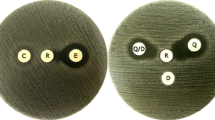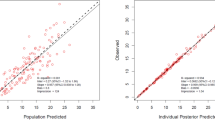Summary:
Gram-positive breakthrough infections pose a major drawback to the use of quinolones for antibacterial prophylaxis in neutropenic patients. Levofloxacin offers the advantage of an augmented Gram-positive spectrum and may potentially overcome this problem. In an open-label, clinical pilot study, we investigated the effects on throat and bowel microflora and pharmacokinetics of a once-daily oral dose of 500 mg levofloxacin, during neutropenia in 20 patients with haematological malignancies. Gram-negative bowel flora and Staphylococcus aureus were successfully eradicated. No Gram-negative infections occurred. Minimal inhibitory concentration values for viridans group (VG) streptococci tended to increase, in four patients over 8 mg/l, indicating resistance to levofloxacin. Four patients developed blood-stream infections with levofloxacin-resistant Gram-positive cocci. No significant changes in numbers of anaerobic microorganisms were observed. Pharmacokinetic parameters of levofloxacin, including the maximum serum concentration (Cmax), time to Cmax (Tmax), area under the concentration–time curve (AUC), volume of distribution at steady state (Vss/F) and clearance (CL/F) were not statistically different at first dose and during neutropenia. In conclusion, levofloxacin eradicates Gram-negative microorganisms and S. aureus and spares the anaerobic flora. Its pharmacokinetic profile is unaltered during neutropenia. However, prolonged administration of levofloxacin as antibacterial prophylaxis may be hampered by the emergence of levofloxacin-resistant VG streptococci.
This is a preview of subscription content, access via your institution
Access options
Subscribe to this journal
Receive 12 print issues and online access
$259.00 per year
only $21.58 per issue
Buy this article
- Purchase on Springer Link
- Instant access to full article PDF
Prices may be subject to local taxes which are calculated during checkout

Similar content being viewed by others
References
Engels EA, Lau J, Barza M . Efficacy of quinolone prophylaxis in neutropenic cancer patients: a meta-analysis. J Clin Oncol 1998; 16: 1179–1187.
Rozenberg-Arska M, Dekker AW, Verhoef J . Ciprofloxacin for selective decontamination of the alimentary tract in patients with acute leukemia during remission induction treatment: the effect on fecal flora. J Infect Dis 1985; 152: 104–107.
Bow EJ, Rayner E, Louie TJ . Comparison of norfloxacin with cotrimoxazole for infection prophylaxis in acute leukemia. The trade-off for reduced gram-negative sepsis. Am J Med 1988; 84: 847–854.
Kukuckova E, Spanik S, Ilavska I et al. Staphylococcal bacteremia in cancer patients: risk factors and outcome in 134 episodes prior to and after introduction of quinolones into infection prevention in neutropenia. Support Care Cancer 1996; 4: 427–434.
Bow EJ, Mandell LA, Louie TJ et al. Quinolone-based antibacterial chemoprophylaxis in neutropenic patients: effect of augmented Gram-positive activity on infectious morbidity. National Cancer Institute of Canada Clinical Trials Group. Ann Intern Med 1996; 125: 183–190.
Kern WV, Hay B, Kern P et al. A randomized trial of roxithromycin in patients with acute leukemia and bone marrow transplant recipients receiving fluoroquinolone prophylaxis. Antimicrob Agents Chemother 1994; 38: 465–472.
Ford CD, Reilly W, Wood J et al. Oral antimicrobial prophylaxis in bone marrow transplant recipients: randomized trial of ciprofloxacin versus ciprofloxacin–vancomycin. Antimicrob Agents Chemother 1998; 42: 1402–1405.
International Antimicrobial Therapy Cooperative Group of the EORTC. Reduction of fever and streptococcal bacteremia in granulocytopenic patients with cancer. A trial of oral penicillin V or placebo combined with pefloxacin. JAMA 1994; 272: 1183–1189.
Broun ER, Wheat JL, Kneebone PH et al. Randomized trial of the addition of Gram-positive prophylaxis to standard antimicrobial prophylaxis for patients undergoing autologous bone marrow transplantation. Antimicrob Agents Chemother 1994; 38: 576–579.
de Jong P, de Jong M, Kuijper E, van der Lelie J . Evaluation of penicillin G in the prevention of streptococcal septicaemia in patients with acute myeloid leukaemia undergoing cytotoxic chemotherapy. Eur J Clin Microbiol Infect Dis 1993; 12: 750–755.
Davis R, Bryson HM . Levofloxacin. A review of its antibacterial activity, pharmacokinetics and therapeutic efficacy. Drugs 1994; 47: 677–700.
Fu KP, Lafredo SC, Foleno B et al. In vitro and in vivo antibacterial activities of levofloxacin (L-ofloxacin), an optically active ofloxacin. Antimicrob Agents Chemother 1992; 36: 860–866.
Chien SC, Rogge MC, Gisclon LG et al. Pharmacokinetic profile of levofloxacin following once-daily 500-milligram oral or intravenous doses. Antimicrob Agents Chemother 1997; 41: 2256–2260.
Lee LJ, Hafkin B, Lee ID et al. Effects of food and sucralfate on a single oral dose of 500 milligrams of levofloxacin in healthy subjects. Antimicrob Agents Chemother 1997; 41: 2196–2200.
Johnson EJ, MacGowan AP, Potter MN et al. Reduced absorption of oral ciprofloxacin after chemotherapy for haematological malignancy. J Antimicrob Chemother 1990; 25: 837–842.
Brown NM, White LO, Blundell EL et al. Absorption of oral ofloxacin after cytotoxic chemotherapy for haematological malignancy. J Antimicrob Chemother 1993; 32: 117–122.
Yeh SP, Hsueh EJ, Yu MS et al. Oral ciprofloxacin as antibacterial prophylaxis after allogeneic bone marrow transplantation: a reappraisal. Bone Marrow Transplant 1999; 24: 1207–1211.
Prentice HG, Hann IM, Nazareth B et al. Oral ciprofloxacin plus colistin: prophylaxis against bacterial infection in neutropenic patients. A strategy for the prevention of emergence of antimicrobial resistance. Br J Haematol 2001; 115: 46–52.
van Kraaij MG, Dekker AW, Peters E et al. Emergence and infectious complications of ciprofloxacin-resistant Escherichia coli in haematological cancer patients. Eur J Clin Microbiol Infect Dis 1998; 17: 591–592.
Cometta A, Calandra T, Bille J, Glauser MP . Escherichia coli resistant to fluoroquinolones in patients with cancer and neutropenia. N Engl J Med 1994; 330: 1240–1241.
Hoogkamp-Korstanje JA . In vitro activities of ciprofloxacin, levofloxacin, lomefloxacin, ofloxacin, pefloxacin, sparfloxacin and trovafloxacin against Gram-positive and Gram-negative pathogens from respiratory tract infections. J Antimicrob Chemother 1997; 40: 427–431.
Bauernfeind A . Comparison of the antibacterial activities of the quinolones Bay 12-8039, gatifloxacin (AM 1155), trovafloxacin, clinafloxacin, levofloxacin and ciprofloxacin. J Antimicrob Chemother 1997; 40: 639–651.
Razonable RR, Litzow MR, Khaliq Y et al. Bacteremia due to viridans group Streptococci with diminished susceptibility to levofloxacin among neutropenic patients receiving levofloxacin prophylaxis. Clin Infect Dis 2002; 34: 1469–1474.
Siegrist HH, Nepa MC, Jacquet A . Susceptibility to levofloxacin of clinical isolates of bacteria from intensive care and haematology/oncology patients in Switzerland: a multicentre study. J Antimicrob Chemother 1999; 43 (Suppl. C): 51–54.
van der Waaij D . Selective decontamination of the digestive tract: general principles. Eur J Cancer Clin Oncol 1988; 24 (Suppl. 1): S1–S4.
Child J, Mortiboy D, Andrews JM et al. Open-label crossover study to determine pharmacokinetics and penetration of two dose regimens of levofloxacin into inflammatory fluid. Antimicrob Agents Chemother 1995; 39: 2749–2751.
Acknowledgements
This study was supported in part by a grant from Aventis Pharma BV, Hoevelaken, The Netherlands.
Author information
Authors and Affiliations
Corresponding author
Rights and permissions
About this article
Cite this article
Timmers, G., Dijstelbloem, Y., Simoons-Smit, A. et al. Pharmacokinetics and effects on bowel and throat microflora of oral levofloxacin as antibacterial prophylaxis in neutropenic patients with haematological malignancies. Bone Marrow Transplant 33, 847–853 (2004). https://doi.org/10.1038/sj.bmt.1704431
Received:
Accepted:
Published:
Issue Date:
DOI: https://doi.org/10.1038/sj.bmt.1704431
Keywords
This article is cited by
-
Oral microbial changes and oral disease management before and after the treatment of hematological malignancies: a narrative review
Clinical Oral Investigations (2023)
-
Review: Levofloxacin Prophylaxis in Pediatric Oncology Patients
Current Treatment Options in Pediatrics (2022)
-
Oral microorganisms and bloodstream infection in allogeneic hematopoietic stem cell transplantation
Clinical Oral Investigations (2021)
-
Antibiotic prophylaxis in children with cancer or who have undergone hematopoietic cell transplantation
European Journal of Clinical Microbiology & Infectious Diseases (2014)
-
Impact of bloodstream infections on outcome and the influence of prophylactic oral antibiotic regimens in allogeneic hematopoietic SCT recipients
Bone Marrow Transplantation (2011)



